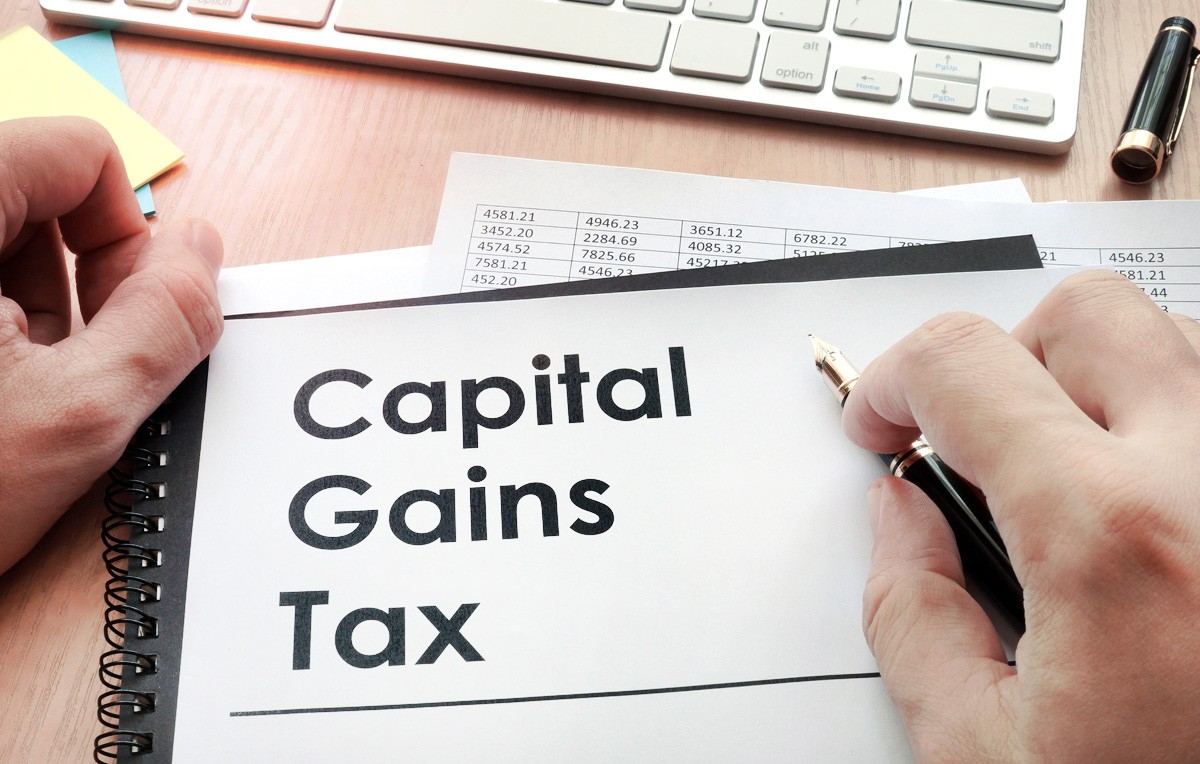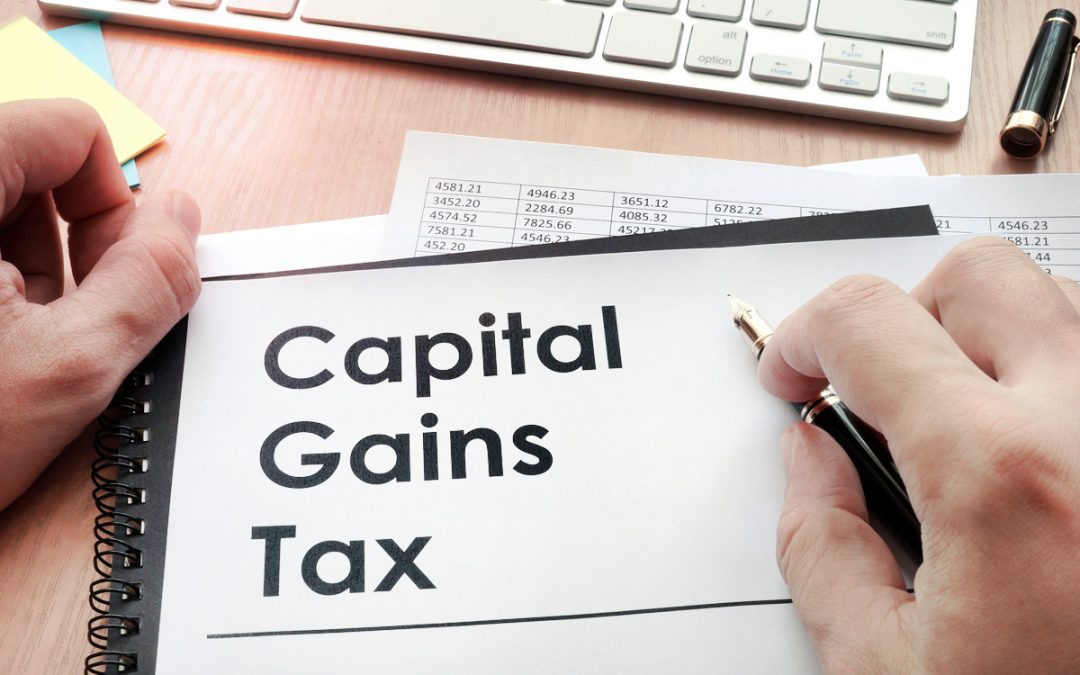
For those investors out there who would like to ensure they maximize their profits, it’s best to be well informed when it comes to capital gains taxes. It can mean the difference between paying a reasonable amount of taxes, to an outrageous amount that breaks the bank. You’re investing to make a profit, get ahead of the game, and build wealth, so sending a good portion of your money to the IRS is probably not your goal. With that in mind, let’s take a look at capital gains and losses, as well as strategies for reducing your tax burden, current tax rates, and everything in between.
What are Capital Gains Taxes?
When you sell an asset, such as real estate, stocks, or cryptocurrencies, and a gain occurs, you are expected to pay what is called a capital gains tax. A gain is realized if the asset sells for more than the adjusted original purchase price. The tax rate that will be applied to the gain would depend upon your filing status, your income level, and whether or not it was a long-term or short-term investment.
Basic Capital Gains Terminology & Definitions
If you’re new to the topic of capital gains tax, then it would be beneficial to have a basic understanding of a few key terms that pertain to it. With that said, dive into the information below to increase your knowledge base:
1. Capital Assets
Items you own, whether for personal, business, or strictly investment purposes, can be considered a capital asset. This includes such items as property, stocks, cryptocurrency, collectible art, machinery, and more.
2. Capital Gains & Losses
When a capital asset is sold, and the price that it sold for is higher than the original purchase price, it’s considered a capital gain. In contrast, when an asset is sold for a price that is lower than its original cost, it’s considered a capital loss. In most cases, the investor can take advantage of their losses by using them to offset their gains, which can result in a lower tax burden.
3. Short-Term & Long-Term Capital Gains
The amount of taxes you will have to pay on a capital asset that has a gain will depend on how long you held the asset before selling it. If it’s held for less than one year, it’s considered a short-term capital gain, and if it’s held for over a year, it’s a long-term gain. This is important to consider because short-term gains are taxed at a higher rate. Many investors hold on to their assets for more than a year for this reason.
4. Unrealized & Realized Gains and Losses
If a capital asset has increased or decreased in value, but it has not been sold yet, which happens often with stocks that fluctuate on a daily basis, it’s labeled an unrealized gain or loss. On the other hand, when an asset has increased or decreased, and has been sold, it’s then considered to be realized.
5. Cost Basis & Sell Price
The cost basis and sell price are part of the equation when determining your capital losses or gains. The cost basis is the price that a capital asset was purchased for, with various allowable adjustments factored in with the purpose of raising the base amount. The sell price is just that, the price the asset was sold for. The difference between the cost basis price and the selling price will result in your realized loss or gain.
Capital Gains Tax Rates
An important element used in calculating what you might owe the IRS is capital gains tax rates. In general, for long-term capital gains, the federal rates are 0%, 15%, or 20%. Short-term capital gains are taxed at your ordinary tax rate.
2021 Long-Term Capital Gains Tax Rates
As per the IRS, the following federal tax rates should be used to calculate your capital gains tax for assets that were sold after a holding period of longer than one year, as seen in the following table:
| Filing Status | 0% | 15% | 20% |
|---|---|---|---|
| Single | Up to $40,400 | $40,401 to $445,850 | Over $445,850 |
| Married Filing Separately | Up to $40,400 | $40,401 to $250,800 | Over $250,800 |
| Married Filing Jointly | Up to $80,800 | $80,801 to $501,600 | Over $501,600 |
| Head of Household | Up to $54,100 | $54,101 to $473,750 | Over $473,750 |
For those investors who realized a gain on a collectible item such as art, stamps, jewelry, and the like, the above rates will not apply. Items such as these are taxed at a designated rate of 28%. Speak with your tax advisor to see if your investment falls into a special tax rate bracket.
2021 Short-Term Capital Gains Tax Rates
Gains that are considered short-term are taxed against the following federal tax rate percentages:
| Tax Rate | Single | Married Filing Jointly | Married Filing Separately | Head of Household |
|---|---|---|---|---|
| 10% | Up to $9,950 | Up to $19,900 | Up to $9,950 | Up to $14,200 |
| 12% | $9,951 to $40,525 | $19,901 to $81,050 | $9,951 to $40,525 | $14,201 to $54,200 |
| 22% | $40,526 to $86,375 | $81,051 to $172,750 | $40,526 to $86,375 | $54,201 to $86,350 |
| 24% | $86,376 to $164,925 | $172,751 to $329,850 | $86,376 to $164,925 | $86,351 to $164,900 |
| 32% | $164,926 to $209,425 | $329,851 to $418,850 | $164,926 to $209,425 | $164,901 to $209,400 |
| 35% | $209,426 to $523,600 | $418,851 to $628,300 | $209,426 to $314,150 | $209,401 to $523,600 |
| 37% | Over $523,600 | Over $628,300 | Over $314,150 | Over $523,600 |
State Capital Gains Tax
Keep in mind that in addition to paying federal taxes on your gains, you may also have to pay taxes on the state level. Although some states do not charge capital gains taxes, many do, and the rates range between 2.90% and 13.30%. Take a look at this page by World Popular View that provides details and charts on all the individual capital gain state taxes.
The Wealthy May See an Increase in Taxes
The Biden administration is currently proposing an increase in federal capital gains taxes for those making $1 million or more. This could bring an investor’s tax rate up from what might end up being the previous higher tier of 20% to a new higher rate of 39.6%. Additionally, if the investor is subjected to the net investment income tax of 3.8%, they will be required to pay a high rate of 43.4%.
If applicable, once state tax is factored in, investors may be looking at a tax rate that’s around 48%. Furthermore, changes to the top marginal (ordinary) taxable income rate are in the works; it could rise from 37% to 39.6%.
How are Capital Gains Calculated and Taxed?
Determining your capital gains and how much they will be taxed on a federal level is typically accomplished by taking the following steps:
Step 1: Determine Your Cost Basis
This is the purchase price, plus any fees or commissions you paid. If your asset is real estate, any eligible improvement costs should be added to the basis.
Step 2: Make Note of Your Selling Price
Determine your price by taking the amount of money you sold the investment for and subtracting any fees you paid during the selling process.
Step 3: Subtract the Basis from Sales Price
The next step is to minus your base price from your selling price; this will provide you with your realized gain or loss. If your asset was sold for a higher price than you paid for it, then it’s considered a capital gain. If your selling price is less than the cost basis, then it’s a capital loss.
Step 4: Determine Investment timeframe
Using a gain as an example, based on the date you first acquired your asset, it will be labeled as a long-term (longer than 1-year), or short-term (less than 1-year), capital gain. This determination will be needed to find your specific capital gains tax rate.
Step 5: Locate Your Tax Rate
Depending on if your investment was held for less than or longer than one year, you would refer to either the short-term or long-term tax rate charts above. Once you locate your tax rate based on the length of time held, filing status, and your income level, that are shown in the charts, proceed to the next step.
Step 6: Multiply the Tax Rate by the Gain
Take your gain and multiply it by your designated tax rate percentage; this will provide you with the amount you owe the IRS.
Strategies for Reducing Your Capital Gains Tax
Many investors, depending on the amount of their gain, can be hit hard with taxes. Because of this, wise investors implement strategies to lower capital gains taxes. After all, they are investing to make money and build wealth, not to send the majority of their profits to the IRS. Plus, tax-lowering strategies are legitimate and essential to an investor’s ROI. With that in mind, let’s jump into a few strategies that will help you keep more money in your pocket.
1. Long-Term Investments
One of the most common strategies for reducing your capital gains tax is to hold assets longer than one year so they are classified as long-term investments, and taxed as such. Avoiding selling your investments before you have reached the one year mark will ensure your sell is not labeled a short-term investment where you are taxed at your ordinary rate, which can be as high as 37% in some cases. For instance, it can mean the difference between being taxed at 15%, as compared to higher rates of 24% or 37%.
2. Use Tax-Loss Harvesting to Offset Gains
Utilizing capital losses to offset gains is called “tax-loss harvesting”. Using the stock market as an example, it entails strategically selling a stock that will produce a loss, typically at the end of the calendar year, to offset realized gains, which reduces the amount of taxes owed.
For those who have losses that are greater than their gains, the IRS only allows investors to utilize $3,000, or $1,500/married filing separately, of capital losses to offset gains in one calendar year. Any amount larger than this will be labeled as a capital loss carryover, meaning it can be moved over to the next calendar year to reduce your future tax burden.
Beware of the Wash Sale Rule when Tax-Loss Harvesting
The money from the stock that was sold for a loss for the purpose of being used as a tax advantage, can be reinvested by purchasing additional stocks. However, the IRS states that the investor must wait 30 days before reinvesting in an identical stock. If this does occur, it’s labeled a “wash sale” and will not be allowed to be used as a tax deduction against any gains.
For instance, if you sell 20 shares of XYZ stock, just to offset a gain, and then the next day, repurchase that same exact stock, it’s a wash – as if you never sold it. It’s worth mentioning that this is not the case when trading cryptocurrencies because of the fact that they are deemed property. If you sell a digital currency at a loss, the 30 day rule does not apply.
3. Wait to Sell Your Investments Until After You Retire
For those investors who think their retirement income will be lower than prior non-retirement years, it would be advantageous to wait and sell your investments after you retire. Selling at a time when your tax bracket reflects a lower income will result in owing less capital gains taxes. However, if you think that your income will be higher during that time, this strategy would be counterproductive.
4. Utilize Taxed-Advantaged Retirement Accounts
5. Defer Paying Your Capital Gains Tax with a 1031 Exchange
If you’re a real estate investor, you can lower your capital gains tax burden when you utilize a 1031 Exchange. Typically, when you sell a property, you will have to pay capital gains taxes on the profit of the sale. However, a 1031 exchange was designed to allow the investor to defer paying capital gains taxes that may have resulted from selling the property, if the property owner turns around and invests that gain into a like-kind property.
Like-kind simply refers to buying a similar asset. For instance, you could not sell a property and then reinvest all the money into the stock market. You would have to invest in a similar asset such as another property. You can read more about eligible exchanges in this article posted by the IRS – Like-Kind Exchanges – Real Estate Tax Tips.
This allows you to avoid paying a capital gains tax for the time being, until you sell the final property. There is no limit as to the number of 1031 exchanges you can do, stemming from that first property. Many investors time their final sale of the last property at a time when their tax bracket may be lower.
There are many rules and regulations when doing a 1031 exchange, so if you’re not familiar with the process, it’s best to seek out the help of a real estate professional who does, or a certified CPA who is experienced on the topic. We use Tom Wheelwright of Wealthability for our tax needs, he’s excellent. You can connect with him through our personal Lower Your Taxes page.
6. Take the Allowable Exclusion on the Sale of Your Primary Residence
Typically referred to as the IRS Primary Residence Exclusion, it allows homeowners who have lived in their home for two of the previous five years, to exclude up to $250,000, or $500,000 for those who are married and filing jointly. Read this article by the IRS for more details on the topic.
7. Invest in Opportunity Zones for Big Tax Breaks
Opportunity zones were created as part of an economic development tool that enables those who are interested, to place their gains into low-income areas of the United States that are in need of physical and economic restoration. In doing so, the investor not only improves areas that are in desperate need of change, but can also take advantage of some great tax benefits.
If a property is sold and produces a capital gain, and it’s reinvested into an opportunity zone, there are three options for tax benefits:
- Deferring Capital Gains Taxes: The investor will be able to defer their eligible gain if they reinvest in a qualified opportunity fund (QOF) by 180 days. You can obtain more details on this from the official IRS page that covers QOFs. The tax deferral will end if the investment is sold, or the deferral will automatically end by the expiration date of 12/31/2026, whichever comes first. It is at this time when the gains will be subjected to taxation.
- Tax Benefit – 5 and 7 years: For those who hold their opportunity zone investments for up to 5 years, their basis, which is the amount of the original investment cost, will receive an increase of 10% of the gain that has been deferred. If it’s held longer than 7 years, the basis will be increased an additional 5%, bringing it to a total of 15%.
- Tax Benefit – Over 10 Years: Investors who meet certain requirements and who have held the investment for up to 10 years might be able to avoid capital tax gains altogether, and be able to have the basis of the investment increased to the fair market value of when the investment is sold. Most properties increase in value over time, so this is a great tax advantage.
For even more details on this topic, listen to this excellent podcast of ours titled – How to Invest in Opportunity Zones with Eddie Lorin
Additional Articles by Morris Invest
If you’re a serious investor, then you will want to ensure all your bases are covered. There is no better way to do this than to gain as much knowledge as possible. With that said, dive into the articles below that interest you the most:
- If you invest in real estate, take a moment to read this tax-based post.
- Learn everything you need to know about cash flow in this excellent article.
- Dive into this post that covers investing in stocks and real estate.
- Everyone should have an estate plan, find out what steps to take.
- Learn how to value real estate to determine your property’s worth.
- Investors should know the ins and outs of equity, learn more.
- Invest in rental real estate with multiple investors; this post explains how.
Reduce Your Capital Gains Taxes and Increase Your ROI
We hope our article has given you some excellent capital gains tax reduction strategies so that you can keep more money in your pocket. After all, most likely, you’re in business to build wealth, as well as grow your investment portfolio, and having more funds increases the likelihood of that becoming a reality. Additionally, if you’re a property investor and would like to work with a full-service investment company that can take care of all the details for you, feel free to schedule a complimentary call with Morris Invest – we would love to speak with you to discuss your interests and goals.
Before you go, take a moment to dive into the following video. It discusses the differences between capital gains and cash flow. We think you will find it interesting, and it might even change your perspective on how you’re investing.
Ready To Build Passive Income Through Rental Real Estate?
Ready to talk about your goals? We're here to show you the tools and teach you the process to begin earning legacy wealth for you and your family.









